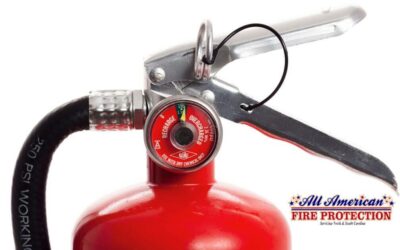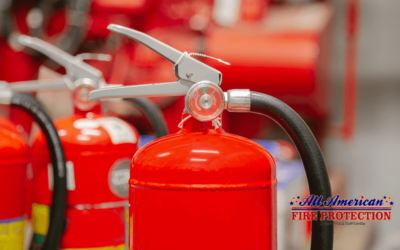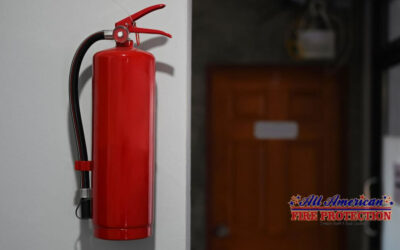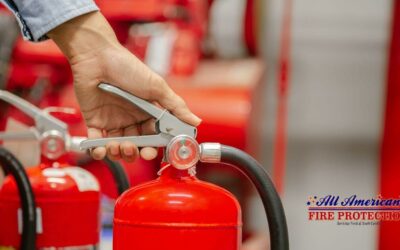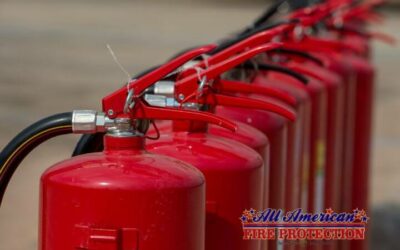Understanding the Importance of a Functional Fire Extinguisher
A fully operational fire extinguisher is a vital component of any safety protocol, serving as the initial countermeasure against the outbreak of small fires. Its availability equips individuals with the capability to swiftly and efficiently suppress flames, potentially preventing a minor incident from escalating into a full-blown disaster. The effectiveness of this device hinges on its readiness for immediate action, a state maintained through vigilant upkeep and timely replacement. Neglecting the condition of your fire extinguisher can significantly narrow the critical window to stop a fire in its early stages, potentially leading to dire repercussions. Recognizing when to replace a fire extinguisher is not merely a procedural requirement; it’s an indispensable aspect of safeguarding lives and property, a responsibility that All American Fire Protection takes seriously with their fire extinguisher service.
Recognizing Signs That Indicate Replacement Is Needed
Fire extinguishers have a finite service life, and certain telltale signs can signal when it’s time to consider a replacement. Be on the lookout for the following indicators:
- Inspect the hose or nozzle for any signs of cracking, blockages, or damage that could impede the flow of the extinguishing agent.
- Examine the handle to ensure it is secure and intact; a compromised handle could hinder your ability to operate the device effectively.
- Check for a current inspection tag; its absence, or a maintenance date that has lapsed, suggests the extinguisher may not be up to date with required servicing.
- Verify that the locking pin is intact and has not been broken or tampered with, which could indicate prior use or misuse.
- Look over the extinguisher for any physical damage, such as dents or rust, or for residue that could affect its structural integrity and performance.
- If the extinguisher has been deployed, even if only partially, its efficacy for future use may be in question unless it is designed to be rechargeable and has been professionally recharged and inspected.
- For certain types of extinguishers, gently shake the canister to check for agent settlement or caking; if the contents do not move freely, the extinguisher may not operate as expected in an emergency.
These signs are pivotal; should you encounter any, it’s prudent to consult with a fire safety professional to determine whether your extinguisher requires servicing or immediate replacement.
Visual Inspection for Damage and Corrosion
Conducting regular visual inspections is a critical step in ensuring the reliability of your fire extinguisher. Through these inspections, you can spot any physical impairments or corrosive damage that might compromise the device’s effectiveness. Here’s a guide to a comprehensive visual check:
- Survey for external damage: Scrutinize the extinguisher for any dents, leaks, or signs of wear that could affect its ability to withstand pressure.
- Look for signs of corrosion: Examine the extinguisher for rust or other corrosive damage, particularly in areas prone to moisture accumulation, such as the base or welded joints, which could weaken its structural integrity.
- Verify label clarity and seal integrity: Ensure that instructional labels are clear and intact, and that safety seals have not been tampered with. Clear labeling is essential for proper operation in an emergency, and compromised seals may suggest tampering or use.
- Inspect the discharge mechanism: Carefully check the nozzle and hose for any damage, obstructions, or wear that could obstruct the agent’s release when activated.
Discovering any of these issues during your inspection could be a clear sign that your fire extinguisher requires replacement to maintain safety and compliance.
Checking the Pressure Gauge
Monitoring the pressure gauge is an essential aspect of fire extinguisher upkeep. This gauge provides a visual indication of the extinguisher’s internal pressure and its readiness for operation. Follow these steps to ensure accurate pressure monitoring:
- Find the gauge: Look for the pressure gauge, which is usually situated near the handle or valve and features a dial with a needle pointer.
- Interpret the reading: The gauge will have a designated operational range, often marked in green, indicating the extinguisher is properly pressurized. The needle should rest within this zone to confirm readiness.
- Identify pressure discrepancies: A needle pointing outside the optimal range signals that the extinguisher may be under- or over-pressurized, suggesting potential leaks, previous discharge, or risk of malfunction.
- Evaluate gauge condition: Ensure the gauge is free from damage and the display is not obscured. A compromised gauge can lead to inaccurate readings and might necessitate replacement.
Regular checks of the pressure gauge are vital, as improper pressure levels could indicate the need for professional servicing or potential replacement of the extinguisher.
Staying Informed on Manufacturer’s Recommendations and Recalls
Maintaining the efficacy of your fire extinguishers is paramount, and this involves more than just routine checks. It requires vigilance in keeping up-to-date with the manufacturer’s guidelines and alerts. These guidelines are the result of meticulous research and testing, designed to maximize both safety and functionality.
Recall notices are urgent communications from manufacturers or regulatory agencies that address defects or non-compliance issues that could compromise safety. Being proactive in monitoring these alerts is essential. In the event of a recall, swift action is necessary to address any potential hazards, which may include specific repairs, replacement, or additional servicing instructions.
Heeding the manufacturer’s advice and responding to recalls are critical steps in safeguarding your property and its inhabitants. By staying informed, you ensure that your fire extinguishers remain operational when you need them most. This proactive approach is an integral part of a comprehensive fire safety plan, reinforcing the importance of timely updates on the status and condition of your fire safety equipment.
Adhering to Manufacturer’s Expiry Recommendations
The lifespan recommendations provided by fire extinguisher manufacturers are essential for ensuring that your equipment remains reliable and effective. Over time, the internal components of an extinguisher can degrade, which may compromise its performance during an emergency.
To comply with these essential guidelines, consider the following steps:
- Consult the manual or label: Determine the expiration date or replacement intervals from the label or accompanying documentation.
- Stick to the schedule: Commit to replacing the fire extinguisher within the timeframe suggested by the manufacturer, which is typically based on the date of manufacture, regardless of whether the unit has been used or appears to be in good condition.
- Maintain records: Utilize a logbook or digital tracking system to monitor expiration dates and maintenance history, ensuring that extinguishers are serviced or replaced as necessary.
- Inform your staff: Train your team to understand the significance of expiration dates and how to locate and interpret the manufacturer’s guidelines.
While regular inspections and monitoring the pressure gauge are important for assessing an extinguisher’s readiness, they do not replace the need to adhere to the manufacturer’s expiry recommendations. Consultations with certified fire safety professionals can provide additional insights into whether an extinguisher is suitable for continued use or if it should be replaced in line with the manufacturer’s guidelines.
By faithfully following the manufacturer’s expiry recommendations, you play a crucial role in maintaining a safe and compliant environment.
Responding to Recall Notices
When a recall notice for fire extinguishers is issued, it’s a critical alert that demands your prompt attention to maintain safety and compliance. To handle a recall notice effectively, take the following steps:
- Verify the details: Cross-reference the model and serial numbers provided in the recall with your fire extinguishers to determine if any are implicated.
- Halt usage at once: Should any of your units be listed, stop using them immediately. A recalled extinguisher might fail when you need it most, presenting a grave danger.
- Reach out for guidance: Adhere to the recall notice’s directions, typically involving reaching out to the manufacturer or the vendor. They will navigate you through the next steps.
- Organize repair or replacement: The manufacturer will clarify if your extinguisher can be fixed or should be entirely replaced, offering these services at no cost as part of the recall protocol.
- Keep meticulous records: Document every step taken in response to the recall, from initial notification to final resolution. This paper trail is essential for compliance, insurance, and safety inspection purposes.
Addressing recall notices with due diligence is an integral component of fire safety management, ensuring that your equipment remains reliable and effective in an emergency.
Reviewing Service History and Professional Inspection Recommendations
Ensuring your fire extinguishers are regularly inspected and serviced by qualified professionals is crucial for their optimal performance. Here’s why it’s important to keep a close eye on your extinguisher’s service history:
- Maintain service logs: Document every inspection, refill, or repair. This log is a testament to the extinguisher’s maintenance and can help predict when it might need replacing.
- Annual professional checks: Have a certified fire safety technician inspect your extinguishers each year. They’ll look for issues that may not be evident without specialized knowledge, such as internal wear or agent efficacy.
- Heed expert advice: Post-inspection, technicians may offer vital insights. If they suggest that an extinguisher is nearing its functional end or fails to meet current standards, it’s imperative to consider their expertise.
- Identify recurring issues: A history of frequent use or repairs might signal an extinguisher that’s more liability than asset, suggesting the need for a replacement.
By actively monitoring service records and valuing the insights of fire safety professionals, you ensure your fire extinguishers are not only compliant but ready to perform when the stakes are high.
Understanding Servicing Intervals
A fire extinguisher’s efficacy hinges on regular maintenance, which is why grasping the servicing intervals is of paramount importance. These intervals are informed by a combination of regulatory mandates, the manufacturer’s guidelines, and the nature of the fire extinguisher in question.
- Routine Checks: On a monthly basis, designated personnel should conduct inspections to verify the extinguisher’s accessibility, integrity, and pressure levels. These checks complement the detailed assessments discussed in earlier sections.
- Annual Examinations: Every year, a certified professional should perform a comprehensive review of the extinguisher. This includes verifying the weight and pressure, as well as ensuring there are no blockages or damage that could hinder functionality.
- In-depth Servicing: Certain types of extinguishers necessitate a more thorough service. For instance, dry chemical extinguishers typically require an internal examination every six years and hydrostatic testing every twelve years to validate the cylinder’s resilience to pressure.
Diligent adherence to these servicing milestones is vital for an extinguisher’s readiness in an emergency. Maintaining meticulous records of all servicing acts as a safeguard, providing a transparent maintenance history that informs timely replacement decisions.
Recognizing End of Life After Multiple Uses or Professional Concerns
Determining when a fire extinguisher should be retired is crucial for maintaining a safe environment. Several factors, including repeated use and professional evaluations, can signal that it’s time for a replacement.
- Frequent Activation: An extinguisher that has been deployed multiple times, even after recharging, may suffer from internal wear or unseen damage. A pattern of recurrent use suggests a heightened risk of fire, underscoring the need for new, dependable extinguishers.
- Expert Recommendations: Fire safety professionals may uncover issues during routine inspections that affect an extinguisher’s reliability. Their guidance on whether an extinguisher should be taken out of service is based on a thorough understanding of safety standards.
- Extinguisher Longevity: Over time, the availability of replacement parts may dwindle, or the extinguisher might fall short of evolving safety regulations. Observing the manufacturer’s expiration date is critical, as is replacing units that no longer meet the latest safety criteria.
Indicators such as erratic pressure readings post-recharge, signs of corrosion, or any damage impacting functionality are telltale signs that an extinguisher has reached its service life limit. When these signs emerge, it’s imperative to decommission the old unit responsibly and invest in a new one that aligns with contemporary safety standards.
Ensuring Compliance with Codes and Regulations
Adhering to established codes and regulations is a critical component of fire extinguisher maintenance. It’s not only about fulfilling legal requirements; it’s about safeguarding lives and property. To guarantee that your fire extinguishers are up to code, consider the following:
- Stay Informed: Keep up-to-date with the guidelines set forth by the National Fire Protection Association (NFPA), particularly NFPA 10, which outlines the standards for portable fire extinguisher placement, inspection, maintenance, and testing. Be mindful of additional local fire codes that may be in effect in your area.
- Annual Inspections: As part of your safety protocol, have fire extinguishers inspected and certified by a qualified professional every year. This practice, as detailed in Understanding Servicing Intervals, should be meticulously recorded and certifications visibly displayed to demonstrate compliance.
- Empower Your Team: Conduct regular training sessions for your staff on the proper use of fire extinguishers. This not only complies with regulations but also ensures that, in the event of a fire, your team can respond effectively and confidently.
- Appropriate Equipment: Ensure that your facility is equipped with the right types and sizes of fire extinguishers, tailored to the specific fire risks present. This strategic placement is crucial for tackling potential fires efficiently.
Staying vigilant with compliance is a dynamic task. Continuously review and adapt to changes in safety standards to maintain the readiness and legality of your fire safety equipment.
Evaluating Impact of Environmental Factors
The reliability and longevity of fire extinguishers can be greatly influenced by their environment. It’s imperative to routinely assess these conditions to maintain extinguisher dependability. Here are key environmental considerations:
- Temperature Fluctuations: Ensure that extinguishers are stored within the manufacturer-recommended temperature range to prevent malfunction or damage due to extreme temperatures.
- Humidity and Corrosion: In environments with high moisture levels, such as coastal or industrial areas, it’s crucial to inspect extinguishers regularly for signs of rust or corrosion, and replace them if necessary.
- UV Radiation: Materials can deteriorate under continuous exposure to UV light. If extinguishers are subject to sunlight, consider using protective covers or repositioning them to reduce exposure.
- Hazardous Chemicals: Keep extinguishers in environments free from aggressive chemicals that could compromise their integrity or the effectiveness of the extinguishing agent.
- Mechanical Stress: In areas with frequent movement or vibrations from machinery or transportation, ensure that extinguishers are securely mounted and inspected for any signs of wear that could affect performance.
By proactively monitoring these environmental elements, you are taking essential steps to ensure that your fire extinguishers remain in peak condition, ready to perform when needed.
Upgrading for Performance and Safety
Elevating your fire safety measures through the enhancement of your fire extinguishers is a critical step in safeguarding your environment. As technology progresses and safety protocols evolve, older extinguisher models may become outdated, potentially compromising safety or falling out of regulatory compliance. Here are compelling reasons to consider an upgrade:
- Technological Advancements: The latest extinguishers on the market may boast superior fire-quenching capabilities, extended longevity, or user-friendly features that can be crucial in an urgent situation.
- Changes in Fire Risks: Modifications in the purpose or layout of your premises might introduce new fire hazards, necessitating extinguishers with different agents or increased capacity.
- Enhanced User Safety: Contemporary extinguishers are often designed with innovative safety mechanisms that reduce the risk of unintended discharge and maximize user protection during use.
- Regulatory Compliance: As highlighted previously, adherence to up-to-date safety regulations is imperative. New extinguisher models are engineered to meet the most current standards.
To ensure your fire extinguishers are at the forefront of efficiency and compliance, consider seeking a professional evaluation. Such a proactive approach not only aligns with the latest safety regulations but also arms your facility with the most advanced tools to effectively confront fire emergencies.


